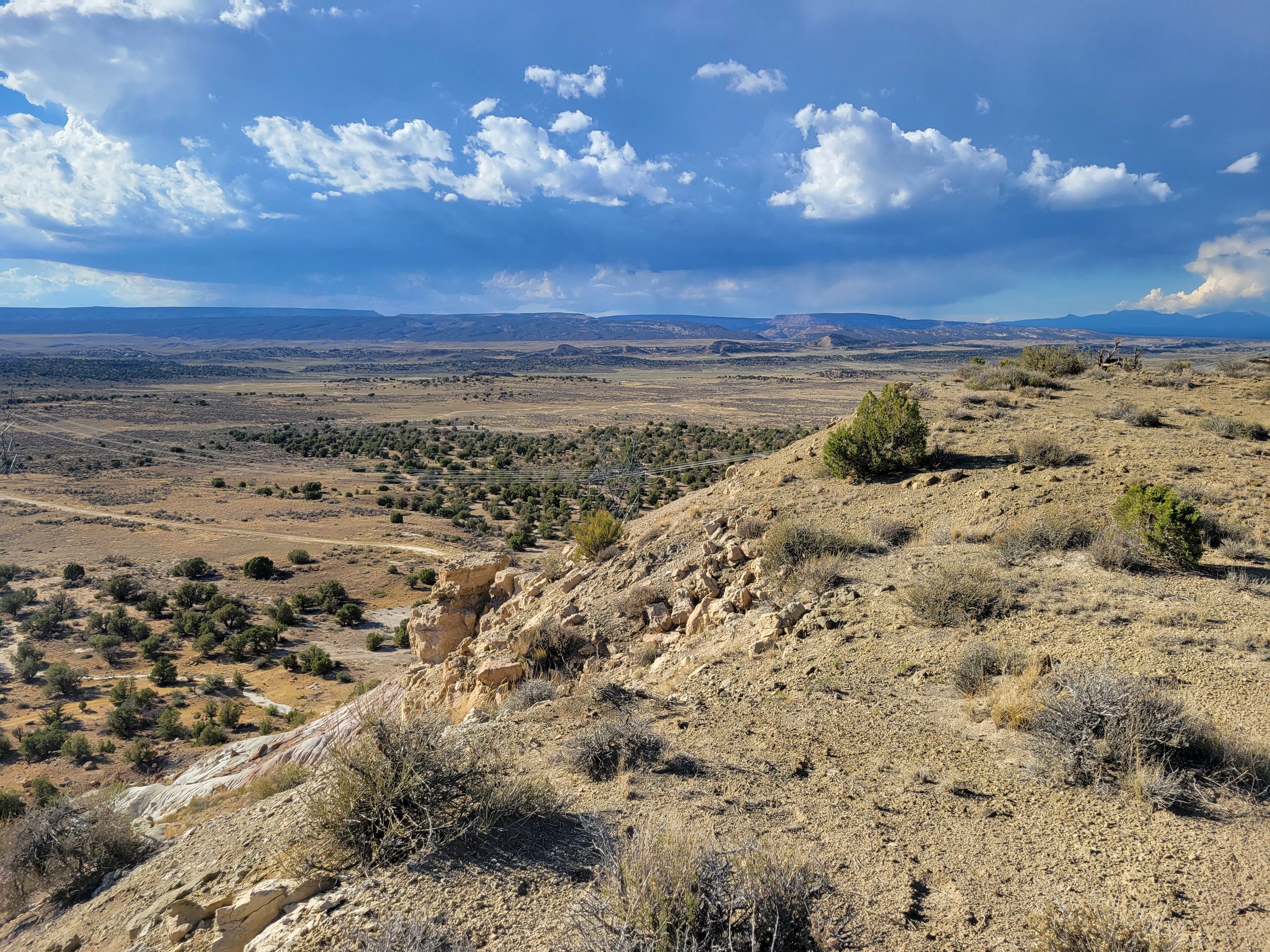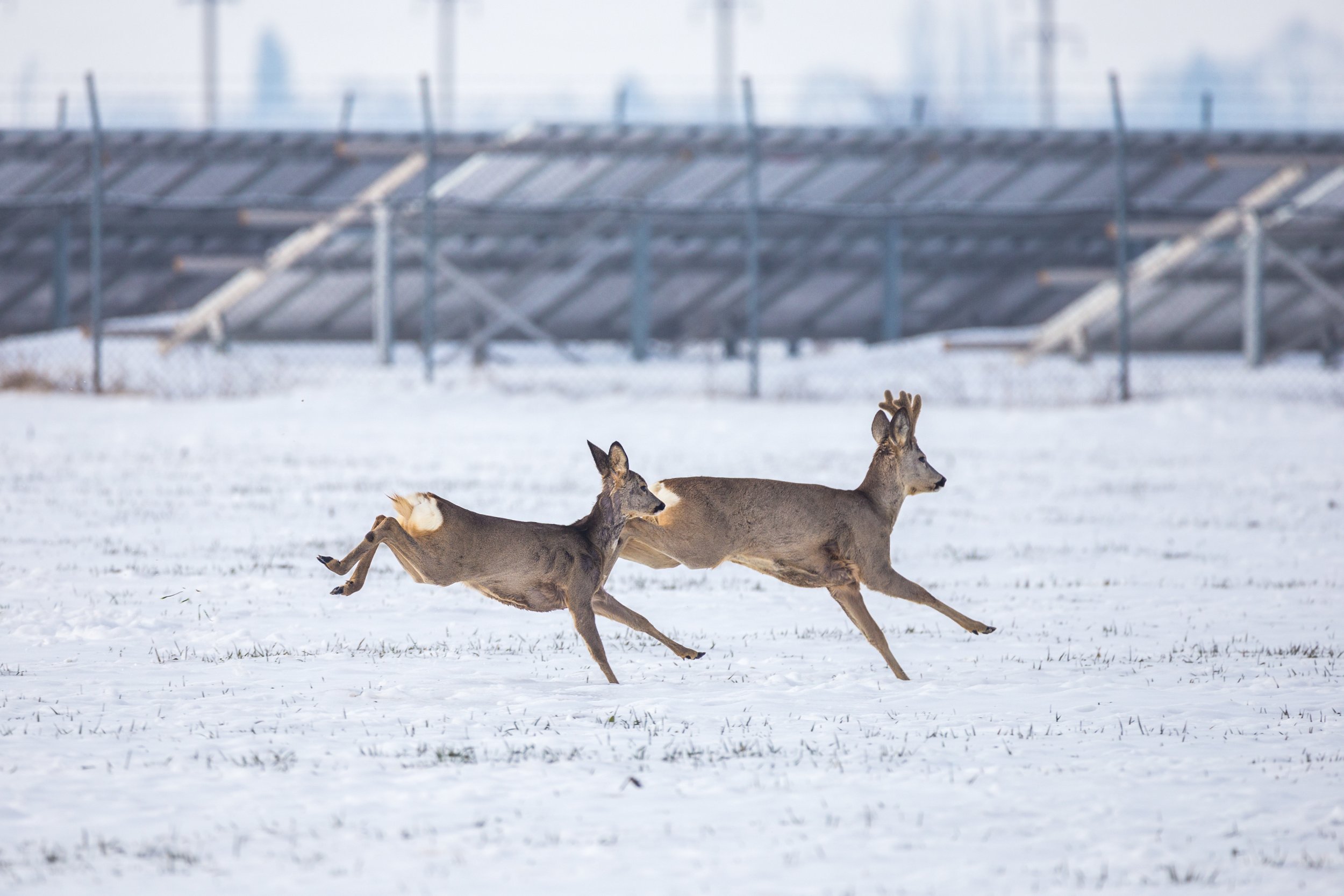Where Clean Energy and Wildlife Restoration Converge
Solar development is heating up. To combat climate change, the pressure is on for governments and corporations to hit renewable energy targets across the United States. In 2021, the White House itself set a target of 80% renewable energy generation by 2030.
As a result, a utility-scale solar energy (USSE) project boom is on its way across the country. Touting many sunny days in a dry climate, the Southwest in particular is a budding gold mine. However, USSE technology is still new, and the emerging regulatory landscape and long-term environmental impacts have resulted in significant uncertainty.
How will solar development impact wildlife movement, populations, and habitat? Nobody knows.
An older, male pronghorn chasing a young buck off his territory in the Four Corners.
“Pronghorns have existed in the face of energy production in this region for a long time. First was the gas and oil extraction, then coal mining and the generating station, and now solar. Yet, they have never been studied in depth,” says Aaron Facka, PhD, Western Senior Wildlife Biologist at Wildlands Network.
In the Four Corners, this isolated herd of pronghorns roams sunbaked plains. While sand-colored backs and white bellies disguise them among deserts and grasslands, they use incredible speed to outrun predators at up to 60 miles per hour (rivaling the cheetah as the second-fastest land mammal). In combination with 300-degree vision, they have evolved over centuries to thrive in flat plains with low vegetation and lots of sun.
Meanwhile, solar development is evolving on a much faster scale. Land for a solar project ideally meets several criteria: minimal topography, minimal vegetation, and high sun exposure. In other words, flat plains with low vegetation and lots of sun.
Power lines stretch through sandy plains in the Four Corners.
As a result, pronghorn habitat and ideal solar development locations overlap in the Four Corners. In addition to the region having high solar energy potential, in 2022, the San Juan Generating Station – a major source of power in the Four Corners – was decommissioned.
In its place, USSE is being developed in close proximity to the generating station to take advantage of the existing transmission infrastructure, since a lack of transmission capacity is often the largest barrier for renewable energy projects sited in rural areas. Collectively, this could result in tens of thousands of acres converted from desert grasslands to solar panels and fencing.
This amount of solar development is expected to displace wildlife and lessen habitat availability and connectivity for pronghorn populations that are already small. The culmination of solar projects, existing oil and gas operations, a decommissioning San Juan Generating Station, and other human development in the area creates extreme accumulated pressure on the natural environment.
Further complicating the issue is a patchwork of federal, state, private, and tribal lands that fragment the region and create barriers to comprehensive management that facilitates wildlife movement. Because regulators don’t have to account for the cumulative effects of projects on neighboring lands, this could result in a situation where a number of relatively small projects near to one another could produce a much larger impact.
Map of the Four Corners and its network of land ownership.
However, no existing regulatory or environmental standards consider these compounding effects. Regulators, USSE developers, land and wildlife managers, and conservation organizations are asked to predict and mitigate the outcomes of USSE to wildlife without sufficient information to do so.
Additionally, there are no standardized methods to study or include wildlife needs into siting or to mitigate the effects of solar on the natural environment. Wildlife considerations tend to come at the end of the planning process, so the development boom is coming without the tools needed to deal with it.
Navajo and Ute Mountain Ute Tribes are a major part of the Four Corners community demanding a solution. “On Navajo Nation, there is a significant data gap concerning pronghorn movements, habitat use, and the broader impacts of solar development on wildlife. The recent surge in solar development permit requests on Tribal lands necessitates proactive measures to address the potential effects on critical wildlife habitat,” says Jessica Fort, Wildlife Biologist at the Navajo Nation Department of Fish and Wildlife.
To address these needs, our team at Wildlands employed our research expertise alongside the Four Corners community. Spearheaded by Aaron Facka and Michael Dax, Western Program Director at Wildlands Network, what started as a long-term interest for Aaron turned into a large-scale research project.
We are now in the process of conducting the largest-scale analysis of the impact of solar development on an ungulate species to date in partnership with the U.S. Department of Energy Solar Energy Technologies Office (SETO), as well as collaborators at the Bureau of Land Management, the Ute Mountain Ute Tribe, Navajo Nation, the New Mexico Department of Game and Fish, Solariant Capital, State of New Mexico Commissioner of Public Lands, and Geosystems Analysis.
“Our research aims to sufficiently document and quantify the presence, relative abundance, habitat needs, and movements of select wildlife, before and after USSE development, and quantify the effects of USSE development on this wildlife,” says Aaron, the project’s primary investigator.
We are using both broadly available spatial models and actual data of land use via camera traps, drones, ground and visual research to monitor pronghorns before, during, and after project development. Field technicians from the Navajo and Ute Mountain Ute Tribes will represent tribal values and knowledge while they are working on the ground with us to gather data.
“This project will help prepare us as managers for the anticipated increase in solar development while safeguarding wildlife populations and their habitats.”
Our research will provide essential information about wildlife to agencies, tribes, solar developers, and conservation organizations working in the community. Pronghorns are an umbrella species in the area, so by studying pronghorns and their habitat, we are also studying smaller mammals that share their home, including prairie dogs, badgers, black-footed ferrets, gray and kit foxes, and burrowing owls.
In addition, the findings will not only support the Four Corners, but can be applied across the entire Western U.S. “Because pronghorn habitat and solar project locations widely overlap, this research can be extrapolated to all similar environments west of the Mississippi. Hundreds of solar projects can benefit from this information,” says Michael.
As a result, the data can be used to help federal, state, and county agencies create environmental regulations to protect wildlife habitat and movement across the country.
Deer running in a snowy field behind solar panels.
We also want to change the way people approach solar project development. “We want to shift the planning process to integrate wildlife needs in site development – for example, siting in less harmful locations, with substantial corridors between panels, and/or with habitat offsets created elsewhere,” says Aaron.
We are shaping the future of conservation and development through community-based restoration and vital on-the-ground research in an urgent field. We are excited to work with the pronghorns, other wildlife, and people that make up the Four Corners community – and to support many more in the process.




